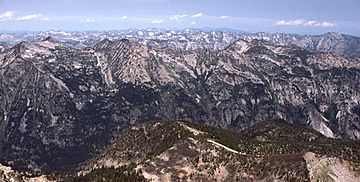Bitterroot Range facts for kids
Quick facts for kids Bitterroot Range |
|
|---|---|

Part of the Bitterroot Range in Montana, looking north from El Capitan peak
|
|
| Highest point | |
| Peak | Scott Peak |
| Elevation | 11,393 ft (3,473 m) |
| Dimensions | |
| Length | 304 mi (489 km) N/S |
| Width | 268 mi (431 km) E/W |
| Area | 14,742 sq mi (38,180 km2) |
| Geography | |
| Country | United States |
| Parent range | Rocky Mountains |
The Bitterroot Range is a long chain of mountains in the Rocky Mountains. It stretches along the border between Montana and Idaho in the northwestern United States. This huge area covers about 24,223 square miles (62,740 km2). The mountains are named after the bitterroot flower (Lewisia rediviva), a small pink flower that is the official state flower of Montana.
Contents
History of the Bitterroot Range
In 1805, the Corps of Discovery, led by Meriwether Lewis and William Clark, explored the Bitterroot Range. They were helped by Sacajawea from the Shoshone Native American tribe.
Lewis first crossed the mountains at Lemhi Pass on August 12. He then went back across the pass to meet Clark. The whole group then crossed the pass to the Salmon River valley.
The next month, they entered the Bitterroot Valley from the south. They likely used either Lost Trail Pass or Chief Joseph Pass. After that, they crossed Lolo Pass to the west. Later, the Chicago, Milwaukee, St. Paul and Pacific Railroad (also known as the "Milwaukee Road") built tracks through these mountains.
Lewis and Clark's Journey
The Bitterroot Mountains were a big surprise for Lewis and Clark. They had hoped to find an easy "Northwest Passage" connecting the Atlantic and Pacific oceans. However, these mountains were a tough obstacle. They showed that such an easy path did not exist.
Main Mountain Ranges
The U.S. Board on Geographic Names says the Bitterroot Range runs from Pend Oreille Lake in Idaho to Monida Pass. Sometimes, people think it goes even further east to include the Centennial Mountains.
The Bitterroot Range is made up of several smaller mountain groups. Here are some of them, listed from north to south:
Coeur d'Alène Mountains
The Coeur d'Alène Mountains are the northernmost part of the Bitterroot Range. They cover an area of about 2,590 square miles (6,700 km2). The two highest peaks in this range are Cherry Peak, which is 7,352 feet (2,241 m) tall, and Patricks Knob, which is 6,837 feet (2,084 m) tall.
Saint Joe Mountains
The Saint Joe Mountains are the smallest named part of the Bitterroot Range. They cover about 698 square miles (1,810 km2). These mountains are located between the St. Joe River to the south and the Coeur d'Alene River to the north. They also border the Slate Creek saddle to the east and a flat area near Moscow, Idaho and Pullman, Washington to the west.
Bitterroot Mountains
The Bitterroot Mountains are the largest part of the Bitterroot Range. They include the Northern and Central Bitterroot Ranges. This area covers about 4,862 square miles (12,590 km2).
These mountains are bordered by Lolo Creek to the north and the Salmon River to the south. To the east, you'll find the Bitterroot River and its valley. To the west are the Selway and Lochsa Rivers. The highest point here is Trapper Peak, standing at 10,157 feet (3,096 m) tall.
Beaverhead Mountains
The Beaverhead Mountains cover an area of about 4,532 square miles (11,740 km2). They are located east of the Bitterroot Mountains. To their west are the Big Hole Basin and the Pioneer Mountains.
Several mountain passes cross through the Beaverheads. These include Lemhi Pass, Bannock Pass, Big Hole Pass, and Monida Pass. The Beaverhead Mountains are also divided into smaller sections like the West Big Hole Mountains and the Tendoy Mountains.
Centennial Mountains
The Centennial Mountains cover an area of about 2,064 square miles (5,350 km2). These mountains are home to Brower's Spring, which was found in 1888 by Jacob V. Brower. This spring is thought to be the furthest point where the Missouri River begins. Brower wrote about his discovery in 1896.
Brower's Spring is located at about 8,800 feet (2,700 m) high in the Centennials. Today, a pile of rocks marks the spot where Hellroaring Creek starts. This creek flows into the Red Rock River. The Red Rock River then joins the Beaverhead River, which flows into the Big Hole River. Finally, these rivers all join the Jefferson River.
In Popular Culture
- The Bitterroot Range is featured in the 2004 alternate history novel, Dies the Fire, by S.M. Stirling.
See also
 In Spanish: Cordillera Bitterroot para niños
In Spanish: Cordillera Bitterroot para niños


